Introduction
This paper reports the description and crystal structure of ferroinnelite, ideally Ba4Ti2Na(NaFe2+)Ti(Si2O7)2[(SO4)(PO4)]O2[O(OH)], a new mineral of the lamprophyllite group (seidozerite supergroup) from the Phlogopite deposit, Kovdor alkaline massif, Kola Peninsula, Russia. In 2008, we were looking for phosphoinnelite to resolve its crystal structure. We were working with a sample of phosphoinnelite from Kovdor from the mineral collection of the late Adriana and Renato Pagano, Milan, Italy (Collezione Mineralogica, sample 9530). We used the microprobe on several crystals but could find no phosphoinnelite, Ba4Na3Ti3Si4O14(PO4,SO4)2(O,F)3, with P > S (Pekov et al., Reference Pekov, Chukanov, Kulikova and Belakovsky2006). However in sample 9530, we discovered a new mineral that we named ferroinnelite. We returned sample 9530 to Renato, except for several crystals that we had analysed with the microprobe. Adriana and Renato Pagano passed away three years ago; since then, all our attempts to get hold of this sample have failed. In this paper, we report experimental results obtained on three crystals of ferroinnelite: crystal 1 (0.120 × 0.100 × 0.025 mm) – crystal-structure refinement #1 and chemical analysis; crystal 2 (0.140 × 0.070 × 0.035 mm) – IR and Raman spectroscopies, crystal 3 (0.127 × 0.097 × 0.046 mm) – crystal-structure refinement #2. The new mineral and its name (symbol Finn) have been approved by the Commission on New Minerals, Nomenclature and Classification, International Mineralogical Association (IMA2024–029, Sokolova et al., Reference Sokolova, Cámara, Hawthorne, Della Ventura and Bernardini2024). The holotype sample of ferroinnelite [a probe mount of the twinned crystal 1 (0.120 × 0.100 × 0.025 mm)] has been deposited in the collections of the Department of Natural History, Royal Ontario Museum (ROM), Toronto, Canada, catalogue number M61038.
Ferroinnelite is a Fe2+ structural analogue of innelite-1A, ideally Ba4Ti2Na(NaMn2+)Ti(Si2O7)2[(SO4)(PO4)]O2[O(OH)] (Sokolova et al., Reference Sokolova, Cámara and Hawthorne2011; Sokolova and Cámara, Reference Sokolova and Cámara2017).
General information on the seidozerite supergroup
There are currently fifty-two TS-block minerals (TS = Titanium Silicate) in the seidozerite supergroup (Memorandum 56-SM/16, Sokolova and Cámara, Reference Sokolova and Cámara2017), forty-five of which are listed in Sokolova and Cámara (Reference Sokolova and Cámara2017); since then, surkhobite has been discredited (IMA 20-A, Sokolova et al., Reference Sokolova, Day, Hawthorne, Agakhanov, Cámara, Uvarova and Della Ventura2021), and eight new mineral species have been added: shkatulkalite, Na2Nb2Na3Ti(Si2O7)2O2(FO)(H2O)4(H2O)3 (Men’shikov et al., Reference Men’shikov, Khomyakov, Polezhaeva and Rastsvetaeva1996, Zolotarev et al., Reference Zolotarev, Selivanova, Krivovichev, Savchenko, Panikorovskii, Lyalina, Pautov and Yakovenchuk2018, Sokolova et al., Reference Sokolova, Day, Hawthorne and Cámara2022a), selivanovaite, Fe3+□Ti2Na□Ti2(Si2O7)2O4(H2O)4 (Pakhomovsky et al., Reference Pakhomovsky, Panikorovskii, Yakovenchuk, Ivanyuk, Mikhailova, Krivovichev, Bocharov and Kalashnikov2018; Sokolova et al., Reference Sokolova, Day, Hawthorne and Cámara2022b), rinkite-(Y), Ca2(CaY)Na(NaCa)Ti(Si2O7)2(OF)F2 (Pautov et al., Reference Pautov, Agakhanov, Karpenko, Uvarova, Sokolova and Hawthorne2019), fluorbarytolamprophyllite, (BaK)Ti2Na3Ti(Si2O7)2O2F2 (Filina et al., Reference Filina, Aksenov, Sorokhtina, Chukanov, Kononkova, Belakovskiy, Britvin, Kogarko, Chervonnyi and Rastsvetaeva2019), bortolanite, Ca2(Ca1.5Zr0.5)Na(NaCa)Ti(Si2O7)2(OF)F2 (Day et al., Reference Day, Sokolova, Hawthorne, Horváth and Pfenninger-Horváth2022), nacareniobsite-(Y), Ca2(CaY)Na3Nb(Si2O7)2(OF)F2 (Agakhanov et al., Reference Agakhanov, Day, Sokolova, Karpenko, Hawthorne, Pautov, Pekov, Kasatkin and Agakhanova2023), nacareniobsite-(Nd), Ca2(CaNd)Na3Nb(Si2O7)2(OF)F2 (Agakhanov et al., Reference Agakhanov, Day, Sokolova, Karpenko, Hawthorne, Pautov, Kasatkin, Pekov, Belakovskiy and Britvin2025) and ferroinnelite (IMA2024-029).
The TS block is the main structural unit in all seidozerite-supergroup structures; it consists of a central O (Octahedral) sheet and two adjacent H (Heteropolyhedral) sheets; Si2O7 groups occur in the H sheets. The TS block is characterised by a planar minimal cell based on translation vectors, t1 and t2, the lengths of which are t 1 ≈ 5.5 and t 2 ≈ 7 Å, and t1 ^ t2 is close to 90°. Minerals of the seidozerite supergroup are divided into four groups based on the content of Ti and the topology and stereochemistry of the TS block: in the rinkite, bafertisite, lamprophyllite and murmanite groups, Ti (+ Nb + Zr + Fe3+ + Mg + Mn) = 1, 2, 3 and 4 apfu (atoms per formula unit) per (Si2O7)2, respectively (Sokolova, Reference Sokolova2006; Sokolova and Cámara, Reference Sokolova and Cámara2013, Reference Sokolova and Cámara2018). The seidozerite supergroup is based on a quantitative classification as minerals of each group have a fixed content of Ti (+ Nb + Zr + Fe3+ + Mg + Mn). Each group of minerals has a TS block with a different (1) content of Ti (+ Nb + Zr + Fe3+ + Mg + Mn), (2) topology defined by the type of linkage of H and O sheets, and (3) stereochemistry of Ti (+ Nb + Zr + Fe3+ + Mg + Mn) (Sokolova, Reference Sokolova2006). There are three topologically distinct TS blocks based on three types of linkage of two H sheets and the central O sheet (Sokolova, Reference Sokolova2006). Linkage 1 occurs where two H sheets connect to the O sheet such that two Si2O7 groups on opposite sides of the O sheet link to trans edges of the same polyhedron of the O sheet. Linkage 2 occurs where two Si2O7 groups link to two octahedra of the O sheet adjacent along t2. Linkage 3 occurs where two Si2O7 groups link to two octahedra adjacent approximately along t1. All TS-block structures consist either solely of TS blocks or of two types of block: the TS block and an I (Intermediate) block that comprises atoms between two TS blocks. Usually, the I block consists of alkali and alkaline-earth cations, H2O groups and oxyanions (PO4)3–, (SO4)2– and (CO3)2–. The general formula of the TS block is as follows: AP 2BP 2MH2MO4(Si2O7)2X4+n, where MH2 and MO4 are cations of the H and O sheets; MH = Ti, Nb, Zr, Y, Mn, Ca + REE and Ca; MO = Ti, Zr, Nb, Fe3+, Fe2+, Mg, Mn, Zn, Ca and Na; AP and BP are cations at the peripheral (P) sites = Na, Ca + REE, Ca, Zn, Ba, Sr and K; X are anions = O, OH, F and H2O; X4+n = XO4 + XP n, n = 0, 1, 1.5, 2 and 4; XP = XP M and XP A = apical anions of the MH and AP cations at the periphery of the TS block. There are four types of self-linkage between adjacent TS blocks (Sokolova, Reference Sokolova2006): [1] TS blocks link directly through common edges of MH and AP polyhedra, and common vertices of MH, AP and Si polyhedra of the H sheets belonging to two TS blocks. [2] TS blocks link through common vertices of Ti(+ Nb) octahedra, and the I block has one layer of cations (m = 1). [3] TS blocks do not link directly, additional cations do not occur in the I space (m = 0), and TS blocks are connected through hydrogen bonds of H2O groups at the XP sites. [4] TS blocks do not link directly, and there are additional layers of cations in the I block (m = 1–6).
Sokolova and Cámara (Reference Sokolova and Cámara2013) introduced the concept of basic and derivative structures for TS-block minerals. A basic structure has the following four characteristics: (1) There is only one type of TS block. (2) The two H sheets of the TS block are identical. (3) There is only one type of I block or it is absent. (4) There is only one type of self-linkage of TS blocks. Basic structures obey the general structural principles of Sokolova (Reference Sokolova2006). A derivative structure has one or more of the three following characteristics: (1) There is more than one type of TS block. (2) There is more than one type of I block. (3) There is more than one type of self-linkage of TS blocks. A derivative structure is related to two or more basic structures of the same group: it can be derived by adding these structures via sharing of the central O sheet of the TS blocks of adjacent structural fragments which represent basic structures. There are five seidozerite-supergroup minerals with derivative structures, four of them occur in the lamprophyllite group.
In the lamprophyllite group, the TS block is characterised by Ti (+ Nb + Fe3+ + Mg) = 3 apfu; Ti occurs in the H sheets (2 apfu) and the O sheet (1 apfu). Linkage 1 occurs: Si2O7 groups of the two H sheets link to trans edges of the Ti octahedron of the O sheet. In the crystal structures of the lamprophyllite-group minerals, TS blocks either alternate with I blocks, self-linkage [4] occurs or connect via hydrogen bonding between H2O groups at the X P sites, self-linkage [3] occurs.
Previous work on innelite
Kravchenko et al. (Reference Kravchenko, Vlasova, Kazakova, Ilyukhin and Abrashev1961) described innelite, (Na,Ca,Mg,Fe3+,Fe2+)3(Ba,K,Mn)4(Ti,Al)3Si4O24 (OH,F)1.5·1.15S, from the Inagli massif, Yakutia, Russia. They reported triclinic symmetry, a chemical analysis (they did not analyse innelite for phosphorous) and deposited the holotype sample at the Fersman Mineralogical Museum, Moscow, Russia (sample #81801, collections of S.M. Kravchenko and A.F. Efimov).
Chernov et al. (Reference Chernov, Ilyukhin, Maksimov and Belov1971) solved the crystal structure of innelite on a single crystal from the holotype sample #81801, described the main features of the structure topology and wrote its ideal formula as Na2Ba3(Ba,K,Mn)(Ca,Na)Ti(TiO2)2 [Si2O7]2(SO4)2. Based on the structure work of Chernov et al. (Reference Chernov, Ilyukhin, Maksimov and Belov1971), Sokolova (Reference Sokolova2006) considered innelite a TS-block mineral and wrote its ideal formula as Na2CaBa4Ti3[Si2O7]2(SO4)2O4.
Pekov et al. (Reference Pekov, Chukanov, Kulikova and Belakovsky2006) reported a chemical composition for innelite from the Inagli and Kovdor massifs, emphasising that innelite contains P (with S > P) and wrote an ‘ideal’ formula of innelite as Ba4(Na,Ca)3Ti3Si4O14(SO4)2(O,OH,F)4; however, they did not list H2O in the chemical analyses and did not include (PO4) in the formula.
In 2008, we obtained a fragment of the holotype sample of innelite (#81801, Inagli, Yakutia, Russia, Fersman Mineralogical Museum) for a comprehensive study using single-crystal X-ray diffraction, electron microprobe analysis (EMPA) and high-resolution transmission electron microscopy (HRTEM). Transmission electron microscopy showed that the sample is an intergrowth of two innelite polytypes, and the crystal structures of innelite-1T (space group P ![]() $\bar 1$) and innelite-2M (space group P2/c; c2M = 2c1T) were solved and refined (Sokolova et al., Reference Sokolova, Cámara and Hawthorne2011). The crystal structure of innelite is a combination of a TS block which consists of HOH sheets and an I block. The I block contains T sites, statistically occupied by S and P, and Ba atoms. Innelite-1T is innelite as described by Kravchenko et al. (Reference Kravchenko, Vlasova, Kazakova, Ilyukhin and Abrashev1961) and Chernov et al. (Reference Chernov, Ilyukhin, Maksimov and Belov1971). Sokolova et al. (Reference Sokolova, Cámara and Hawthorne2011) wrote the ideal structural formula of innelite as Ba4Ti2 Na(NaM2+)Ti(Si2O7)2[(SO4)(PO4)]O2[O(OH)], M2+ = Mn > Fe > Mg > Ca.
$\bar 1$) and innelite-2M (space group P2/c; c2M = 2c1T) were solved and refined (Sokolova et al., Reference Sokolova, Cámara and Hawthorne2011). The crystal structure of innelite is a combination of a TS block which consists of HOH sheets and an I block. The I block contains T sites, statistically occupied by S and P, and Ba atoms. Innelite-1T is innelite as described by Kravchenko et al. (Reference Kravchenko, Vlasova, Kazakova, Ilyukhin and Abrashev1961) and Chernov et al. (Reference Chernov, Ilyukhin, Maksimov and Belov1971). Sokolova et al. (Reference Sokolova, Cámara and Hawthorne2011) wrote the ideal structural formula of innelite as Ba4Ti2 Na(NaM2+)Ti(Si2O7)2[(SO4)(PO4)]O2[O(OH)], M2+ = Mn > Fe > Mg > Ca.
Sokolova and Cámara (Reference Sokolova and Cámara2017) considered innelite a lamprophyllite-group (seidozerite-supergroup) TS-block mineral, redefined its formula based on the work of Sokolova et al. (Reference Sokolova, Cámara and Hawthorne2011) and renamed innelite-1T as innelite-1A (Memorandum 56-SM/16).
Later on, in the IMA list of minerals, the redefined formula of innelite was changed to Ba4Ti2 Na(NaCa)Ti(Si2O7)2[(SO4)(PO4)]O2[O(OH)]. Recently, we pointed out that Mn2+ is the dominant divalent cation at the M O3 site, not Ca. Thus, the formula of innelite was corrected to Ba4Ti2Na(NaMn2+)Ti(Si2O7)2[(SO4)(PO4)]O2[O(OH)] (Bosi et al., Reference Bosi, Hatert, Pasero and Mills2024).
Occurrence and associated minerals
As we found ferroinnelite in a sample of ‘phosphoinnelite’ (see above), information on occurrence, associated minerals and origin of ferroinnelite is taken from Pekov et al. (Reference Pekov, Chukanov, Kulikova and Belakovsky2006). Ferroinnelite occurs in an agpaitic pegmatite vein cross-cutting calcite carbonatite at the Phlogopite deposit, Kovdor alkaline massif, Kola Peninsula, Russia (67°35′21″N and 30°28′4″E). Associated minerals are cancrinite (partly altered to thomsonite-Ca), orthoclase, aegirine–augite, magnesio-arfvedsonite, golyshevite and fluorapatite. The mineral formed in a pegmatite as a result of hydrothermal activity.
Physical properties
Ferroinnelite occurs as transparent elongated platy to tabular crystals up to 0.15 mm long. Figure 1 shows a single crystal of ferroinnelite (0.140 × 0.070 × 0.035 mm) on a glass fibre. Ferroinnelite is yellow to yellow brown; very small grains are pale yellow. The mineral has a white streak and a vitreous lustre. Ferroinnelite does not fluoresce under cathode rays or ultraviolet light. The mineral is brittle, cleavage is {001} medium, the fracture is uneven; no parting was observed. Mohs hardness is ∼5 by analogy with innelite [4.75] (Kravchenko et al., Reference Kravchenko, Vlasova, Kazakova, Ilyukhin and Abrashev1961). The calculated density, D calc., is 4.088 g/cm3.
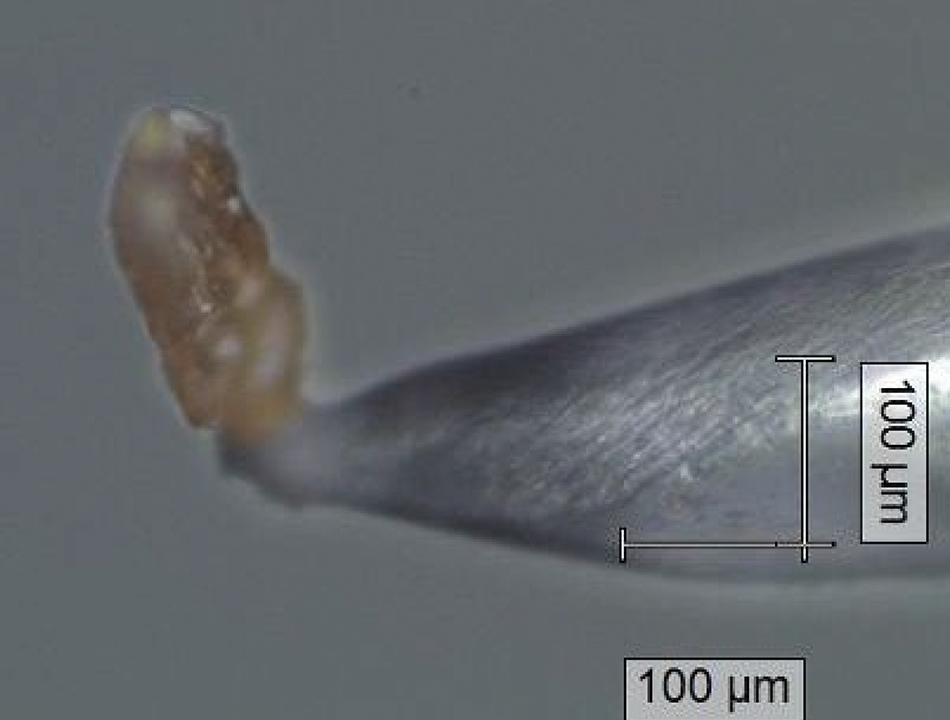
Figure 1. Pale brownish-yellow crystal of ferroinnelite (0.140 × 0.070 × 0.035 mm) on a glass fibre. This crystal was used for IR-spectroscopy at INFN-Laboratori Nazionali di Frascati (Roma), Italy.
Ferroinnelite is biaxial (+). The calculated mean refractive index of ferroinnelite is <n> = 1.823. Canadian safety regulations do not allow use of refractive-index liquids of 1.800 and above and so we cannot measure them. The optic angle, 2V = 87(2)°, was measured on a spindle stage using the method of extinction angles. Ferroinnelite is slightly pleochroic, very pale yellow to yellow brown.
FTIR and Raman spectroscopies
Fourier-transform infrared (FTIR) and Raman single-crystal spectra for ferroinnelite were collected on crystal 2. In particular, the IR spectrum was collected at INFN, Laboratori Nazionali di Frascati (Rome) using a Bruker Hyperion 3000 microscope attached to a Vertex V66 optical bench. Operating conditions were: 4 cm–1 nominal resolution on both peak and background, KBr beamsplitter, MCT N2-cooled detector and an average of 128 scans. The beam size was ∼50 × 50 μm. Raman measurements were done at the Raman Spectra Lab, Department of Science, Roma Tre University, at room temperature using an inVia Renishaw spectrometer equipped with a diode laser (532 nm and output power 100 mW), an edge filter, a 1800 lines per mm diffraction grating and a Peltier-cooled 1024 × 256 pixel CCD detector; the sample was mounted on the manual stage of a Leica DM2700 M confocal microscope. Spectral acquisitions (20 accumulations at 30 s each) were done with a 50× objective and a laser power of 3.5 mW.
A selected FTIR spectrum in the principal (OH)-stretching region of ferroinnelite is given in Fig. 2a, where it is compared with the spectrum collected for holotype innelite 81801 from Yakutia (Fig. 2b). Due to the very small size of the analysed samples, both patterns are very noisy and poorly resolved, however both show undoubtedly the presence of OH groups in the structure. Both spectra consist of a peak at ∼3630 cm–1 and a broad band due to several overlapping components, centred around 3550 cm–1 in ferroinnelite and 3590 cm–1 in innelite; these are superimposed on a very broad absorption centred at ∼3310 cm–1 in ferroinnelite and ∼3469 cm–1 in innelite that can be assigned to H2O groups and eventually moisture adsorbed on the analysed grains.
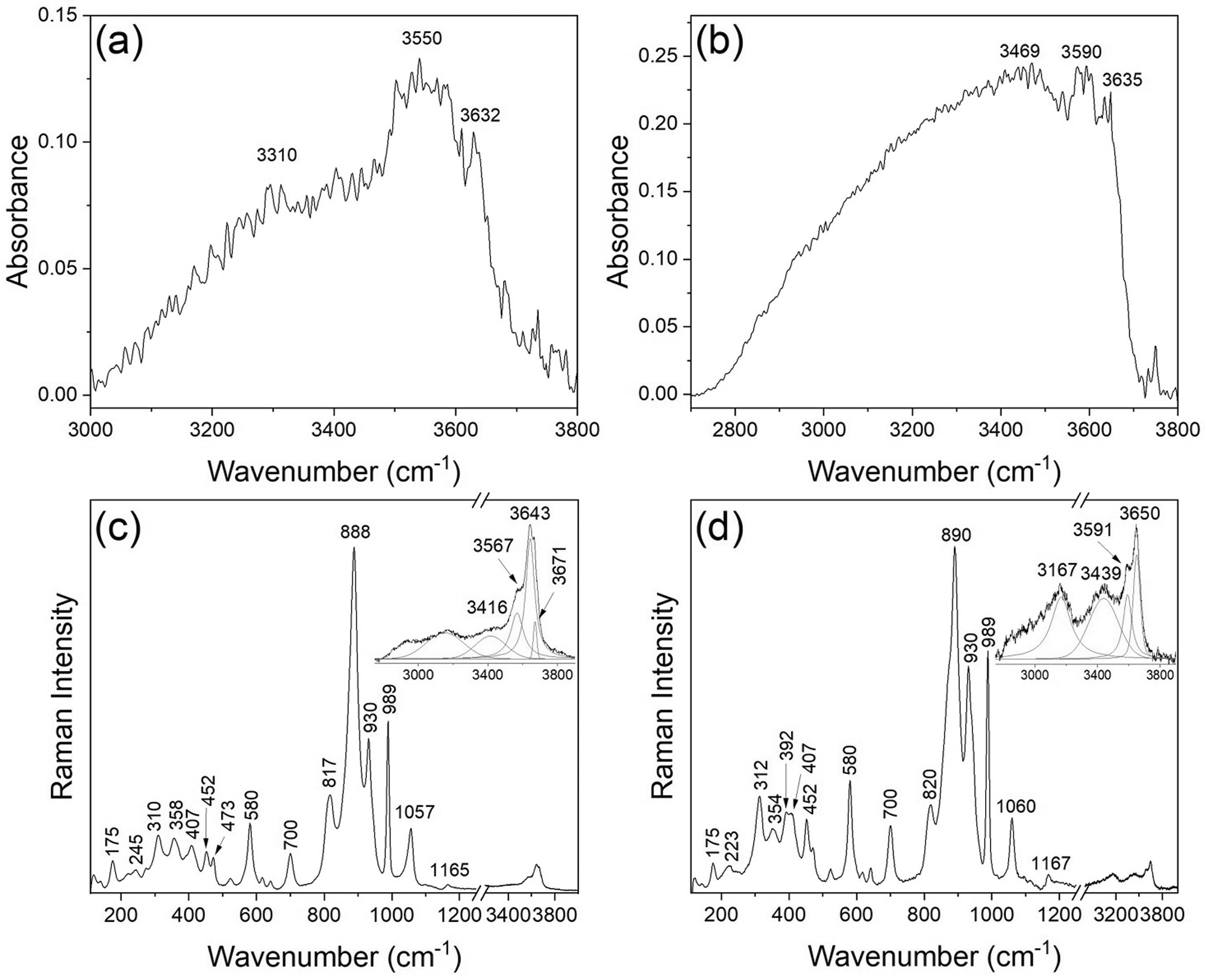
Figure 2. Infrared spectra of (a) ferroinnelite (crystal 9530_2) and (b) holotype innelite (crystal 81801_1) in the principal OH-stretching region; Raman spectra of (c) ferroinnelite and (d) holotype innelite from ∼100 to 4000 cm–1; the OH stretching range is shown in the inset where the pattern decomposition is given as a guide to the eye.
The Raman spectra (Fig. 2c and 2d) show a weak but well-defined (OH)-stretching pattern (see insets in Fig. 2c and 2d) where relatively sharp peaks are resolved at 3567–3591 cm–1 (for ferroinnelite and innelite, respectively) and 3643–3650 cm–1; the higher wavenumber peak of ferroinnelite is split with a second evident component at 3671 cm–1 (Fig. 2c). Two additional broad components at 3416–3439 cm–1 (for ferroinnelite and innelite, respectively), and 3153–3167 cm–1 can be related to H2O. In the low-frequency range (<1200 cm–1), the spectra are very similar and extremely complex and show five intense to relatively intense peaks at frequency > 800 cm–1 plus many lower-intensity peaks at frequencies < 800 cm–1. Based on the literature data for similar TS-block minerals (e.g. Sokolova et al., Reference Sokolova, Abdu, Hawthorne, Genovese, Camara and Khomyakov2015; Cámara et al., Reference Cámara, Sokolova, Abdu and Pautov2016), peaks at frequencies > 800 cm–1 can be assigned to Si–O stretching, whereas peaks at frequencies < 800 cm–1 can be assigned to Si–O bending and to M–O modes. Moreover, the spectra are complicated by the presence of SO4 and PO4 tetrahedra in the I block whose modes typically occur as intense scattering at frequencies > 900 cm–1.
Chemical composition
The ferroinnelite crystal 1 previously used for single-crystal X-ray data collection was analysed with a Cameca SX-100 electron-microprobe operating in wavelength-dispersion mode with an accelerating voltage of 15 kV, a specimen current of 20 nA, a beam size of 10 μm and count times on peak and background of 20 and 10 s, respectively. The following standards were used for Kα or Lα X-ray lines (analysing crystals are given in brackets): F(LTAP): F-bearing riebeckite; Na(TAP): albite; Si(TAP), Ca(LPET): diopside; Nb(PET): Ba2NaNb5O15; P(LPET): apatite; Ti(LLiF): titanite; Sr(LPET): SrTiO3; Ta(LLiF): MnNb2Ta2O9; Mn(LLiF): spessartine; Mg(TAP): forsterite; Fe(LLiF): fayalite; Zr(LPET): zircon; S(LPET), Ba(LiF, L β): baryte; Al(LTAP): andalusite; K(LPET): orthoclase. Data were reduced using the ϕ(ρZ) procedure of Pouchou and Pichoir (Reference Pouchou, Pichoir and Armstrong1985). The chemical composition of ferroinnelite is given in Table 1 and is the mean of 11 determinations.
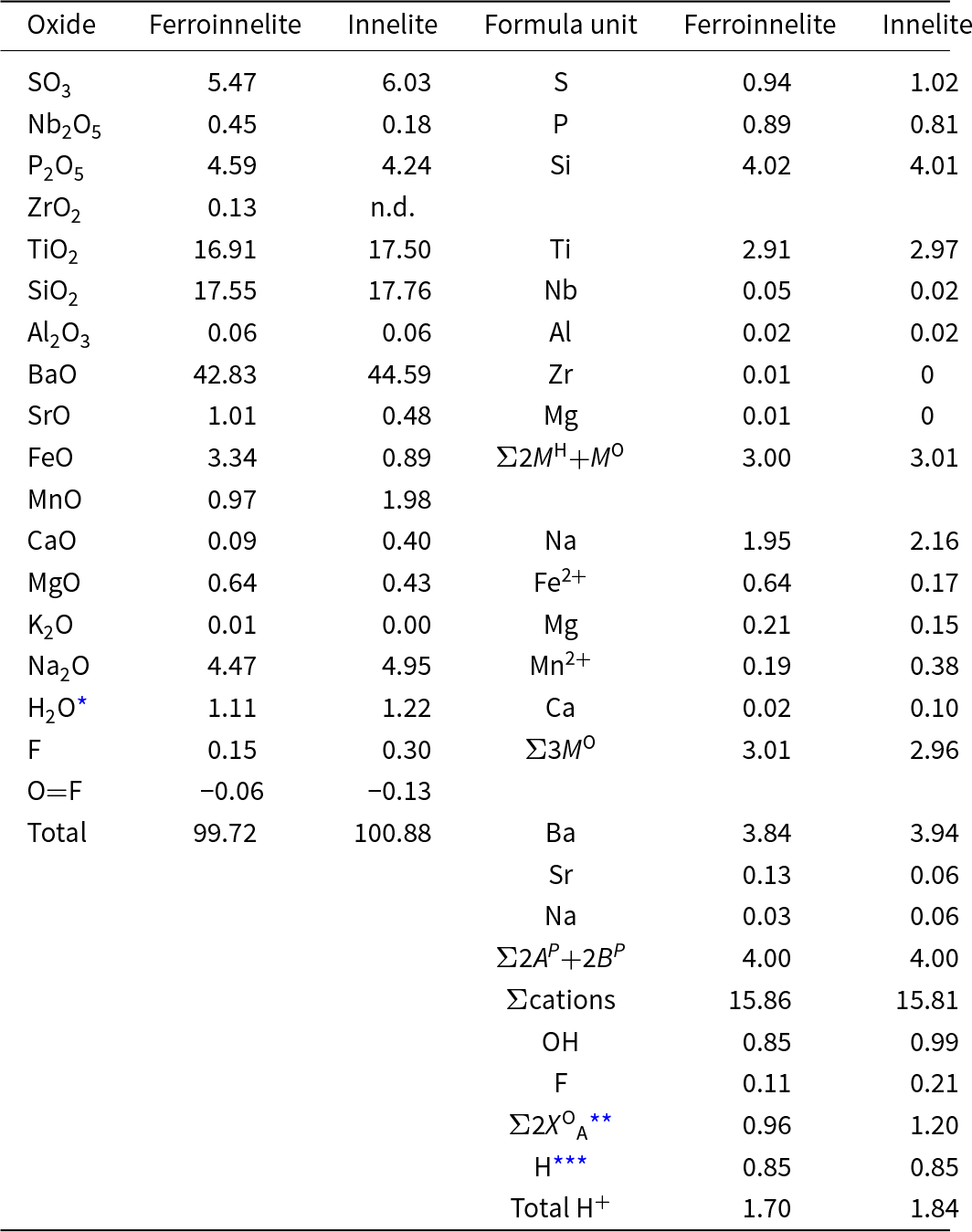
1 this work: EMPA; 2Sokolova et al. (Reference Sokolova, Cámara and Hawthorne2011): EMPA;
* calculated from structure-refinement results: 1[(OH)1.36 and (H2O)0.17] and 2[(OH)1.50 and (H2O)0.17] pfu;
** monovalent anions of the O sheet;
*** content of H+ in the I block from: 1[(OH)0.51(H2O)0.17] and 2[(OH)0.51(H2O)0.17] pfu.
The empirical formula calculated on 26 (O + F) atoms per formula unit (apfu) is (Na1.95Fe2+0.64Mg0.21Mn2+0.19Ca0.02)Σ3.01(Ba3.84Sr0.13Na0.03)Σ4.00(Ti2.91Nb0.05Al0.02Zr0.01Mg0.01)Σ3.00 Si4.02S0.94P0.89H1.70O25.89F0.11, Z = 1. The structural formula based on assigned site-populations (see below) is (Ba3.84Sr0.13Na0.03)Σ4(Ti1.98Al0.02)Σ2Na(Na0.95Fe2+0.64Mg0.21Mn2+0.19Ca0.01)Σ2(Ti0.93Nb0.05Zr0.01Mg0.01)Σ1(Si2O7)2[(SO4)0.94(PO4)0.89(OH)0.51(H2O)0.17]O2[O1.04(OH0.85F0.11)Σ0.96]Σ2. The simplified formula is (Ba,Sr)4Ti2Na(Na,Fe2+,Mg,Mn2+)2(Ti,Nb)(Si2O7)2[(SO4)(PO4)]O2(O,OH)2. The ideal formula of ferroinnelite, Ba4Ti2Na(NaFe2+)Ti(Si2O7)2[(SO4)(PO4)]O2[O(OH)], requires (wt.%): SO3 5.77; P2O5 5.12; TiO2 17.28; SiO2 17.32; BaO 44.21; FeO 5.18; Na2O 4.47; H2O 0.65; Total 100.00.
Powder X-ray diffraction
Powder X-ray diffraction data were obtained by collapsing the entire dataset collected from the single crystal into one dimension. Data (in Å for MoKα) are listed in Table 2. Unit-cell parameters are therefore the same as for the single-crystal data (Table 3).
Table 2. Simulated powder X-ray diffraction data* for ferroinnelite
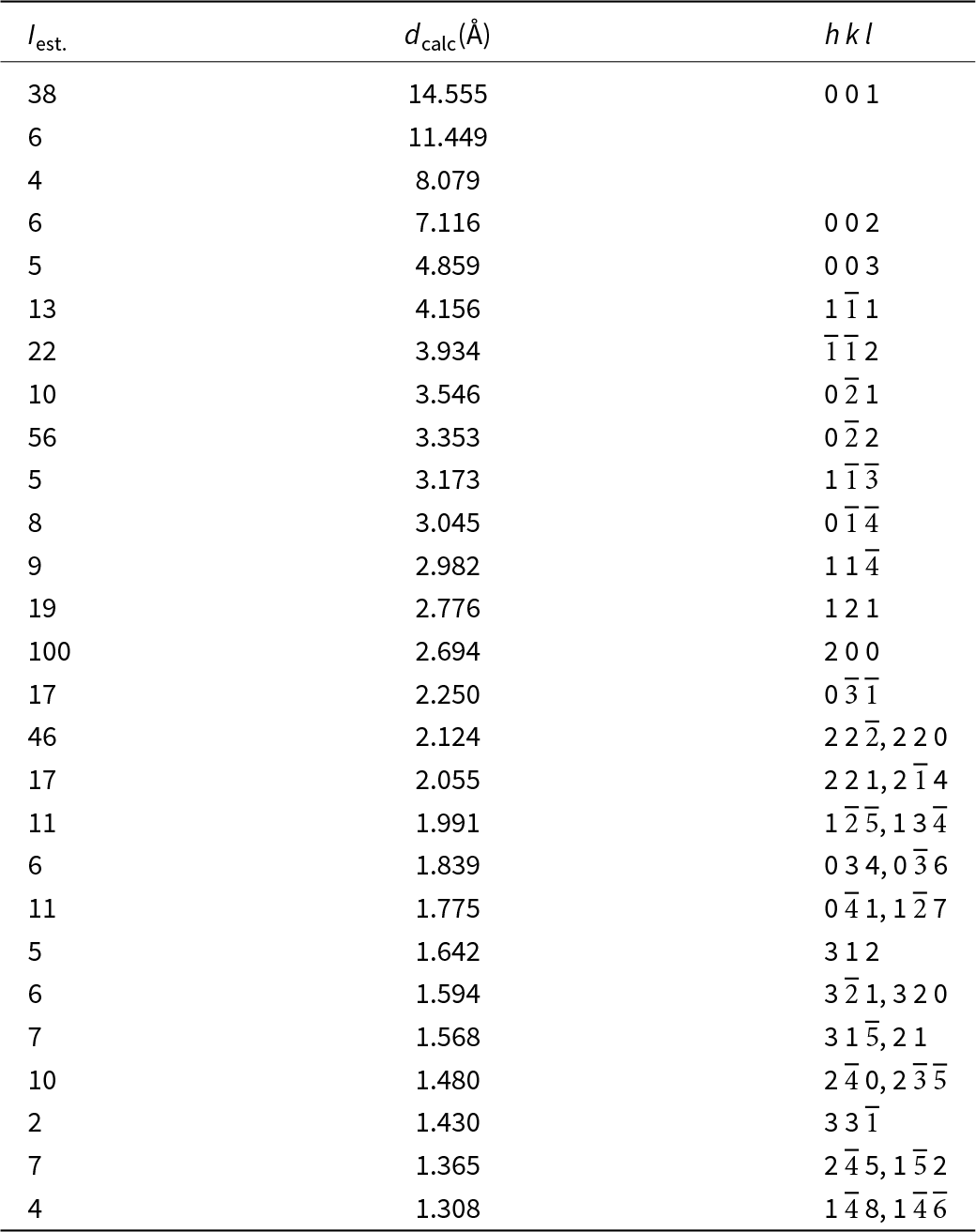
* the entire dataset of images was collapsed in 1D.
Table 3. Miscellaneous refinement data for ferroinnelite
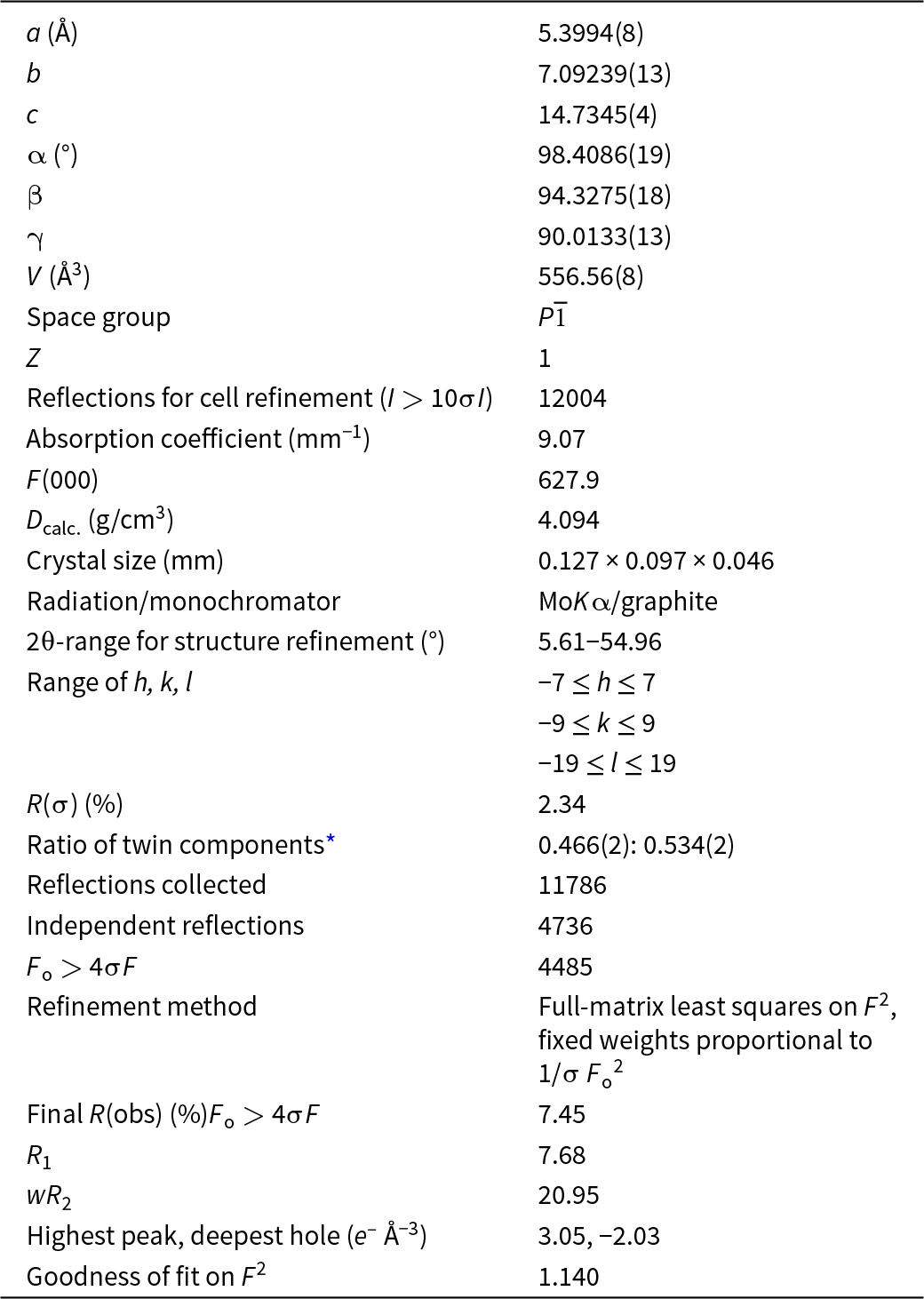
* twin matrix is (![]() $\overline 1 $ 0 0, 0 1 0, 0 0
$\overline 1 $ 0 0, 0 1 0, 0 0 ![]() $\overline 1 $)
$\overline 1 $)
Crystal structure: experimental
Data collection and structure refinement
X-ray single-crystal data for ferroinnelite were collected from a twinned crystal (0.127 × 0.097 × 0.046 mm) with a Rigaku XtaLAB Synergy diffractometer, equipped with a PhotonJet-S (Mo) X-ray source operating at 50 kV and 1 mA, with monochromatised MoKα (0.71073 Å) radiation and equipped with a HyPix-6000HE Hybrid Photon Counting (HPC) detector working at 62 mm from the sample. The intensities of reflections with –9 ≤ h ≤ 9, –12 ≤ k ≤ 12 and –26 ≤ l ≤ 27 were collected with a frame width of 0.5° and a frame time of 40 s up to 2θ ≤ 81.44°, and an empirical absorption correction (SCALE3 ABSPACK, Rigaku Oxford Diffraction, 2018) was applied. There were few observed reflections at high 2θ, and refinement of the structure was done for 2θ ≤ 54°, –7 ≤ h ≤ 7, –9 ≤ k ≤ 9 and –19 ≤ l ≤ 19. The crystal structure was refined to R 1 = 0.0745 on the basis of 4485 unique reflections (F o > 4σ|F|) using atom coordinates of innelite-1A (Sokolova et al., Reference Sokolova, Cámara and Hawthorne2011) with Bruker SHELXTL version 2014/3 software (Sheldrick, Reference Sheldrick2015). The ratio of twin components is 0.466(2): 0.534(2), and the twin matrix is (![]() $\bar 1$ 0 0, 0 1 0, 0 0
$\bar 1$ 0 0, 0 1 0, 0 0 ![]() $\bar 1$). The occupancies of the Ti-dominant M H and M O1 sites were refined with the scattering factor of Ti; alkali-cation sites M O2 with the scattering factor of Na and M O3 with the scattering factor of Fe; Ba-dominant AP and BP sites with the scattering factor of Ba; and the T site with the scattering factor of S. The refined occupancy of the Ti-dominant M O1 site is greater than 1 due to the presence of heavier cations such as Nb and Zr. For the M O2 site, site-occupancy refinement using the scattering factor of Na converged to 1.0 and was fixed at the last stages of the refinement. Neutral scattering factors were taken from the International Tables for X-ray Crystallography (Wilson, Reference Wilson1992). In the last stages of refinement, two subsidiary peaks were included in the refinement with the scattering factor of Ba. The presence of subsidiary peaks is a common feature in Ti silicates with the TS block; they are due to intimate intergrowths of these minerals and the presence of additional structure domains (see HRTEM results for innelite in Sokolova et al., Reference Sokolova, Cámara and Hawthorne2011). Refined site-occupancies of subsidiary peaks were 2 and 3%. The details of X-ray data collection and structure refinement are given in Table 3, final atom parameters are given in Table 4, selected interatomic distances and angles in Table 5, refined site-scattering values and assigned site-populations in Table 6, and bond-valence values in Table 7. A crystallographic information file and a list of observed and calculated structure factors for ferroinnelite have been deposited with the Principal Editor of Mineralogical Magazine and are available as Supplementary Material (see below).
$\bar 1$). The occupancies of the Ti-dominant M H and M O1 sites were refined with the scattering factor of Ti; alkali-cation sites M O2 with the scattering factor of Na and M O3 with the scattering factor of Fe; Ba-dominant AP and BP sites with the scattering factor of Ba; and the T site with the scattering factor of S. The refined occupancy of the Ti-dominant M O1 site is greater than 1 due to the presence of heavier cations such as Nb and Zr. For the M O2 site, site-occupancy refinement using the scattering factor of Na converged to 1.0 and was fixed at the last stages of the refinement. Neutral scattering factors were taken from the International Tables for X-ray Crystallography (Wilson, Reference Wilson1992). In the last stages of refinement, two subsidiary peaks were included in the refinement with the scattering factor of Ba. The presence of subsidiary peaks is a common feature in Ti silicates with the TS block; they are due to intimate intergrowths of these minerals and the presence of additional structure domains (see HRTEM results for innelite in Sokolova et al., Reference Sokolova, Cámara and Hawthorne2011). Refined site-occupancies of subsidiary peaks were 2 and 3%. The details of X-ray data collection and structure refinement are given in Table 3, final atom parameters are given in Table 4, selected interatomic distances and angles in Table 5, refined site-scattering values and assigned site-populations in Table 6, and bond-valence values in Table 7. A crystallographic information file and a list of observed and calculated structure factors for ferroinnelite have been deposited with the Principal Editor of Mineralogical Magazine and are available as Supplementary Material (see below).
Table 4. Atom coordinates and anisotropic displacement parameters (Å2) for ferroinnelite
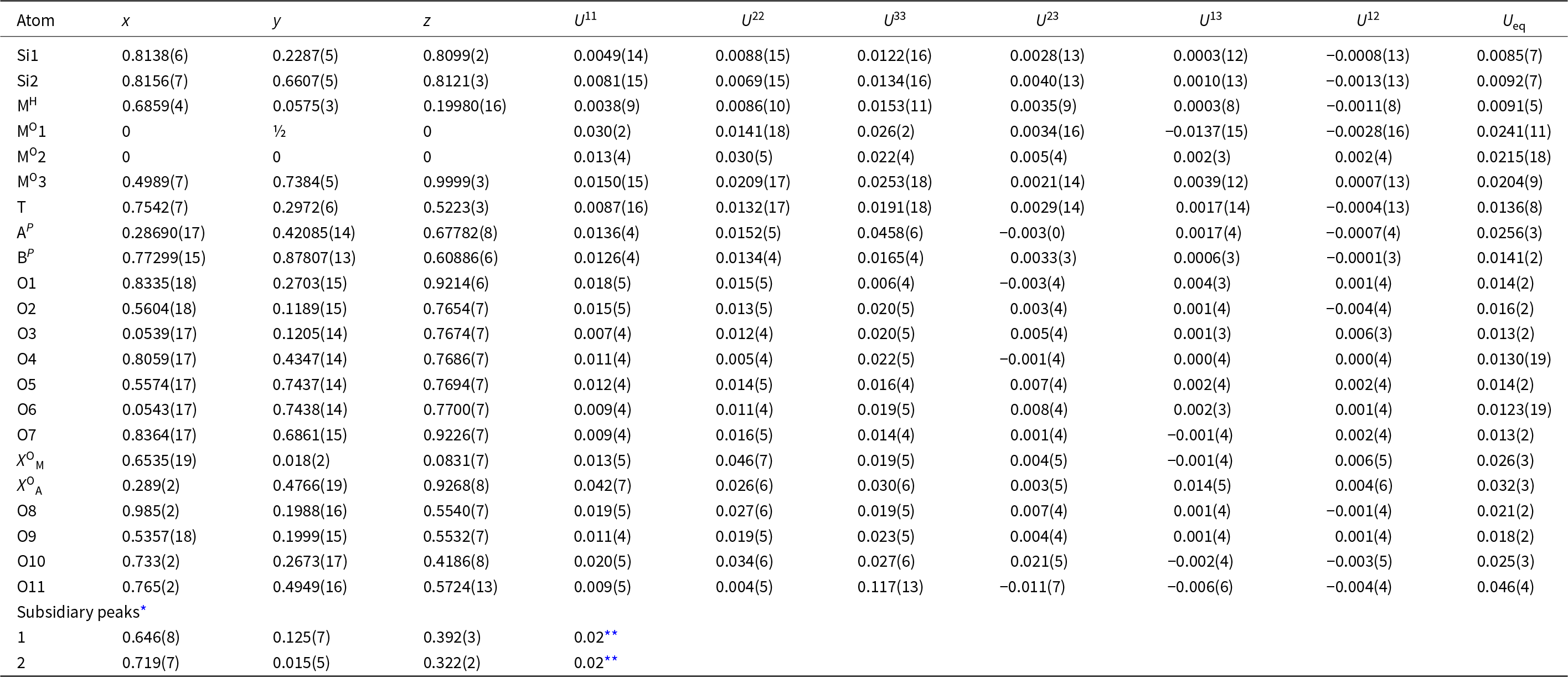
* Site occupancies for 1 and 2 are 0.02 and 0.03, respectively (scattering factor of Ba).
** U iso.
Table 5. Selected interatomic distances (Å) and angles (°) for ferroinnelite
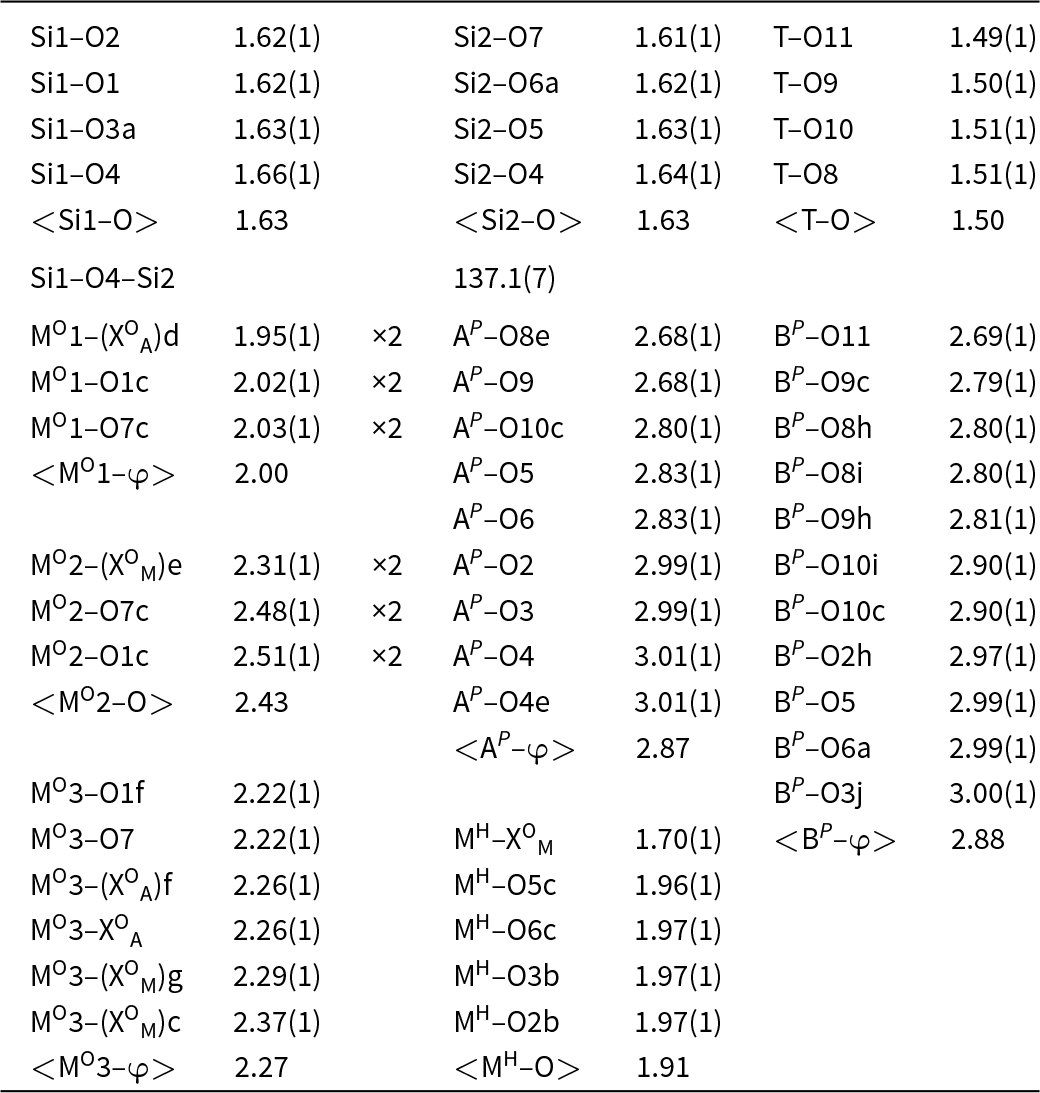
Notes: φ = O, OH and F; Symmetry codes – a: x+1, y, z; b: –x+1, –y, –z+1; c: –x+1, –y+1, –z+1; d: x, y, z–1; e: x–1, y, z; f: –x+1, –y+1, –z+2; g: x, y+1, z+1; h: x, y+1, z; i: –x+2, –y+1, –z+1; j: x+1, y+1, z.
Table 6. Refined site-scattering values (epfu) and assigned site-populations (apfu) for ferroinnelite
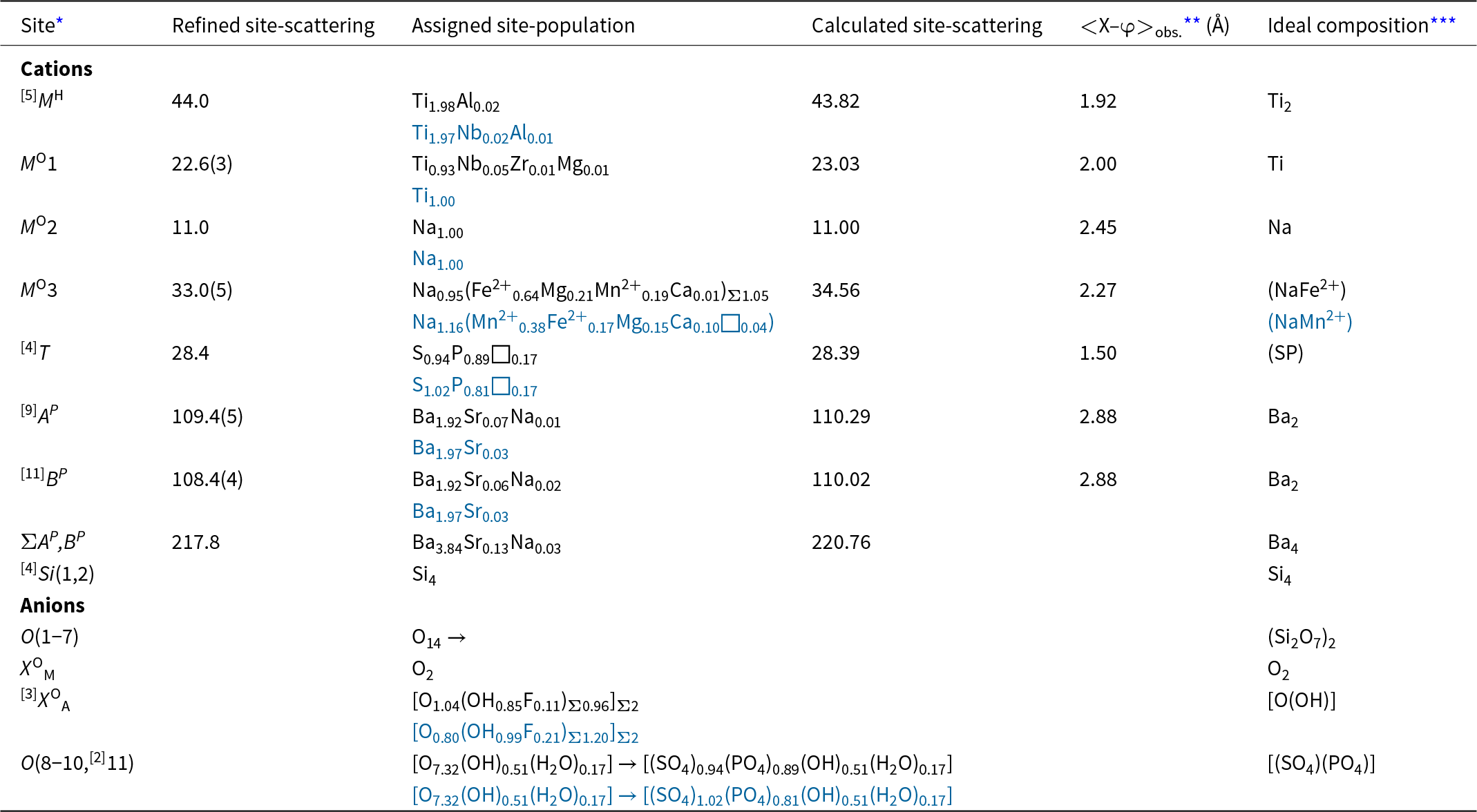
* Coordination numbers are given for non-[6]-coordinated sites;
** φ = O, OH, F, H2O;
*** Compositions and ideal compositions at all sites in ferroinnelite are respectively similar and equivalent to the ones in innelite-1A (shown in blue), except for the M O3 site: (NaFe2+) (ferroinnelite) and (NaMn2+) in innelite-1A (Sokolova et al., Reference Sokolova, Cámara and Hawthorne2011; Sokolova and Cámara, Reference Sokolova and Cámara2017).
Table 7. Bond-valence* (vu) values for ferroinnelite
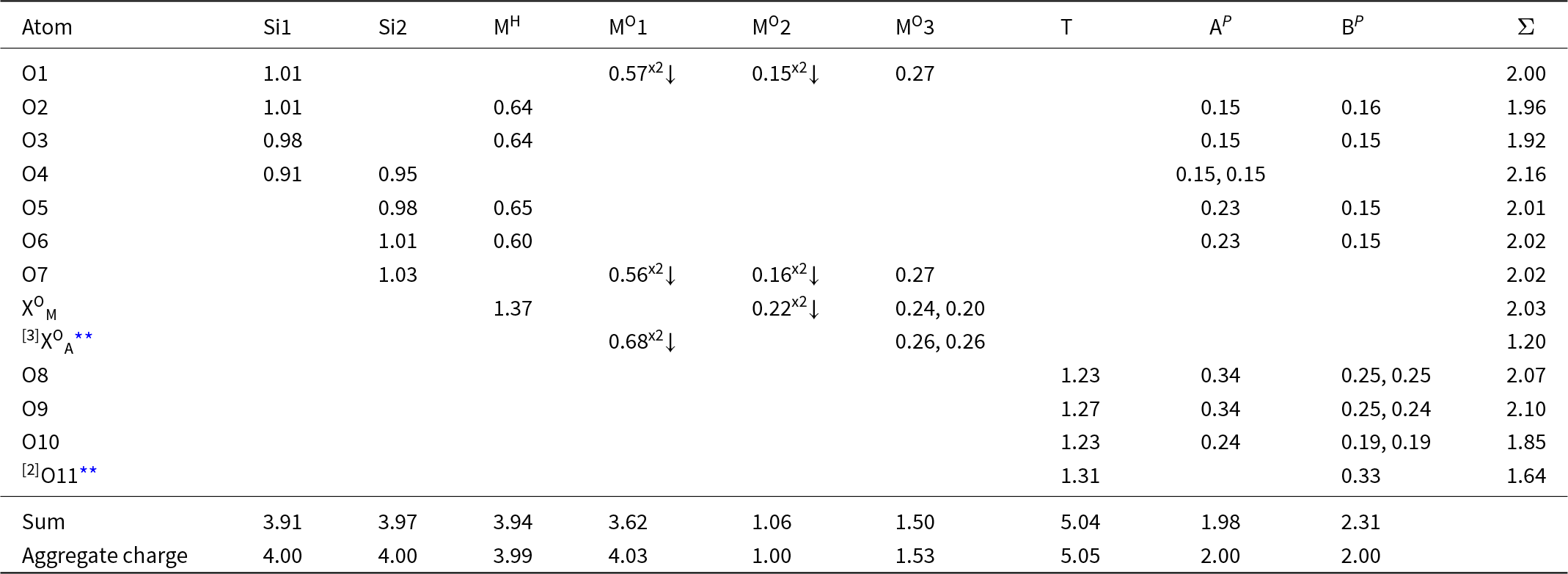
* Bond-valence parameters are from Brown (Reference Brown, O’Keeffe and Navrotsky1981);
** Coordination numbers are given for non-[4]-coordinated anions.
Site-population assignment
We divide the cation sites into 3 groups: M H and Si sites of the H sheet, M O sites of the O sheet, and T, AP and BP sites of the I block. Consider first the Ti (+ Nb)-dominant sites. In TS-block structures, Ti (+ Nb)-dominant sites are always fully occupied. Table 1 shows that the 2M H and 1M O sites are occupied by Ti2.91Nb0.05Al0.02Zr0.01Mg0.01 apfu [66.85 epfu (electrons per formula unit)]. The aggregate refined scattering at these sites (66.6 epfu, Table 4–6) is in agreement with this composition. We assign Ti1.98Al0.02 to the M H site and Ti0.93Nb0.05Zr0.01Mg0.01 to the M O1 site (Table 6). Although the 2M H and 1M O sites are 99 and 93% occupied by Ti (see above), the calculated bond-valence value at the Ti-dominant site in the O sheet is significantly low: 3.62 vu (valence units) when compared to aggregate charges of 3.99+ and 4.03+ for M H and M O1 sites, respectively (Table 7). Although Ti in the O sheet shows low incident bond-valence sums in several lamprophyllite-group minerals, this issue is not yet understood. Consider next the alkali-cation M O(2,3) sites in the O sheet (3 apfu). Table 1 gives Na1.95Fe2+0.64Mg0.21Mn2+0.19Ca0.02, i.e. 3.01 apfu, with a total scattering of 45.76 epfu. The total refined scattering at the alkali sites is 44.0 epfu (Table 6). In accord with the occupancy refinement of the M O2 site (see above), we assign Na to this site (Table 6). To the M O3 site, we assign Na0.95(Fe2+0.64Mg0.21Mn2+0.19Ca0.01), i.e. 2 apfu, (with a total scattering of 34.56 epfu) (Table 6).
Consider last the cation sites in the I block. We assign S0.94P0.89□0.17 pfu (Table 1) to the T site (Table 6). We assign Ba with minor Sr and Na to the peripheral AP and BP sites.
Structure description
Cation sites
The cation sites are divided into 3 groups: the M O sites of the O sheet, the M H and Si sites of the H sheet, and the peripheral AP and BP sites and the T sites in the I block. In accord with Sokolova (Reference Sokolova2006), we label XOM and XOA two anions of the O sheet which do not coordinate Si atoms; XOM = anion at the common vertices of 3 MO and [5]MH polyhedra; XOA = anion at the common vertices of 3 MO octahedra.
There are three cation sites in the O sheet: the M O1, M O2 and M O3 sites are occupied by Ti0.93Nb0.05Zr0.01Mg0.01, Na and [Na0.95(Fe2+0.64Mg0.21Mn2+0.1964Ca0.01)] apfu, respectively, and the ideal compositions of the M O1, M O2 and M O3 sites are Ti, Na and (NaFe2+) apfu (Table 6). The MO1 and MO3 cations are coordinated by four O atoms and two XOA anions (see Anion considerations below) with <MO1–φ> = 2.00 Å and <MO3–φ> = 2.27 Å (φ = O,OH,F) (Tables 4–6; Fig. 3a). The structure diagrams were drawn using Atoms 6.4 software (Dowty, Reference Dowty2016). The MO2 cation is coordinated by six O atoms, with <MO2–O> = 2.43 Å (Table 5). The cations of the O sheet sum ideally to Na(NaFe2+)Ti apfu.
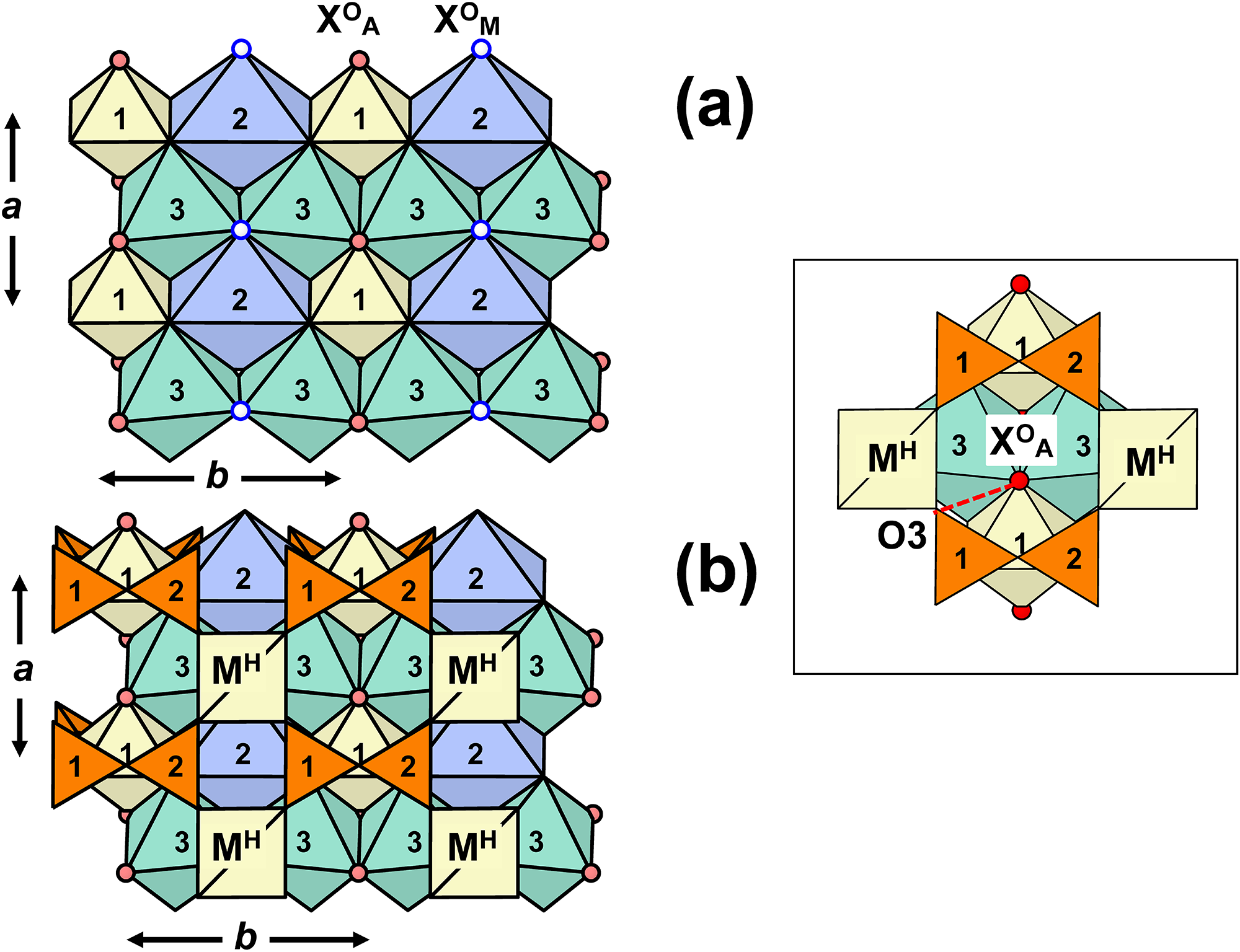
Figure 3. The TS block in the crystal structure of ferroinnelite viewed down [001]: (a) O sheet and (b) linkage of H and O sheets; SiO4 tetrahedra are orange, Ti4+-dominant polyhedra are yellow, Na octahedra and (Na,Fe2+) octahedra are navy blue and bluish-green, respectively; XOM [O] and XOA [O,(OH)] anions are shown as small white circles with green rims and pink spheres. Labels 1 and 2 (on orange) correspond to Si(1,2) tetrahedra, respectively. Labels 1–3 correspond to MO(1–3) octahedra in the O sheet, respectively. Inset on the right shows a possible hydrogen bond XOA–O3 where the M O3 site is occupied by Na and the X OA site is occupied by an OH group shown as a small red sphere. The structure diagrams were drawn using Atoms 6.4 software (Dowty, Reference Dowty2016).
In the H sheet, there are two tetrahedrally coordinated Si sites, occupied by Si, with <Si–O> = 1.63 Å (Table 6, Fig. 3b). The [5]-coordinated M H site is occupied mainly by Ti (Table 6) and is coordinated by O atoms, with <MH–O> = 1.92 Å; the very short MH–XOM distance of 1.70 Å (Table 5) is in accord with the structure topology of lamprophyllite-group minerals (Sokolova, Reference Sokolova2006). For the two H sheets, the sum of the cations is ideally Ti2Si4 apfu.
In the I block, there are two distinct peripheral AP and BP sites (Fig. 4). The [9]-coordinated AP and [11]-coordinated BP sites are occupied mainly by Ba (Table 6). The AP and BP sites are coordinated by O atoms of the H sheet and O atoms (or OH and H2O groups) of the I block (see below), with <AP–φ> = 2.87 and <BP–φ> = 2.88 Å, respectively (Fig. 5a,b). The ideal composition of the two AP and BP sites is Ba4 apfu. There is one T site occupied by S0.94P0.89□0.17 pfu, ideally (SP) apfu, and coordinated by four O atoms, with <T–O> = 1.50 Å (Tables 5, 6; Figs 4, 5a). The three sites in the I block ideally give Ba4(SP) apfu.
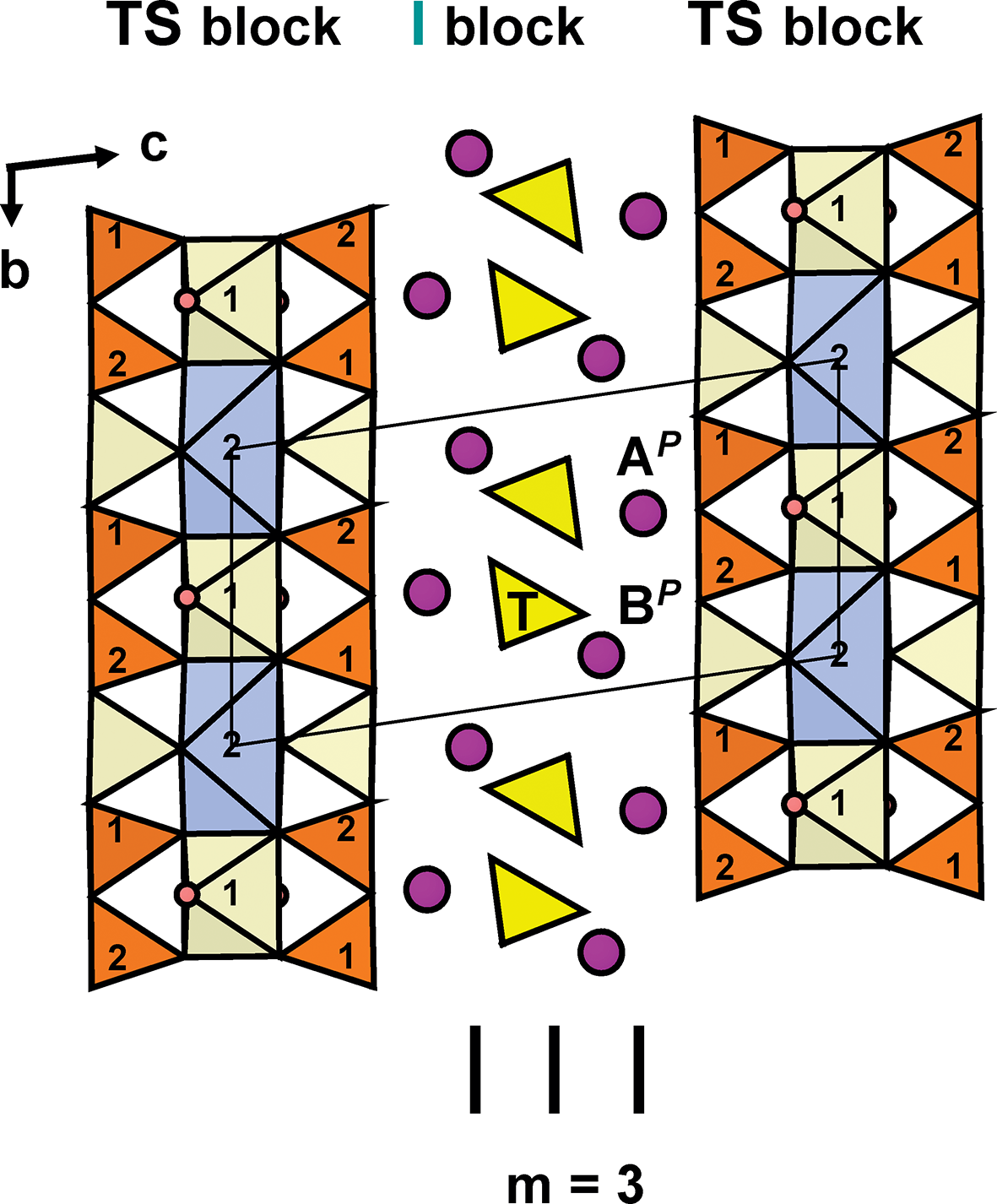
Figure 4. The crystal structure of ferroinnelite projected onto (100). Legend as in Fig. 3; Ba atoms at the AP and BP sites are shown as raspberry-coloured spheres, TO4 (T = S,P) tetrahedra are yellow. The three vertical lines show the positions of the cation layers (m = 3) in the I block.
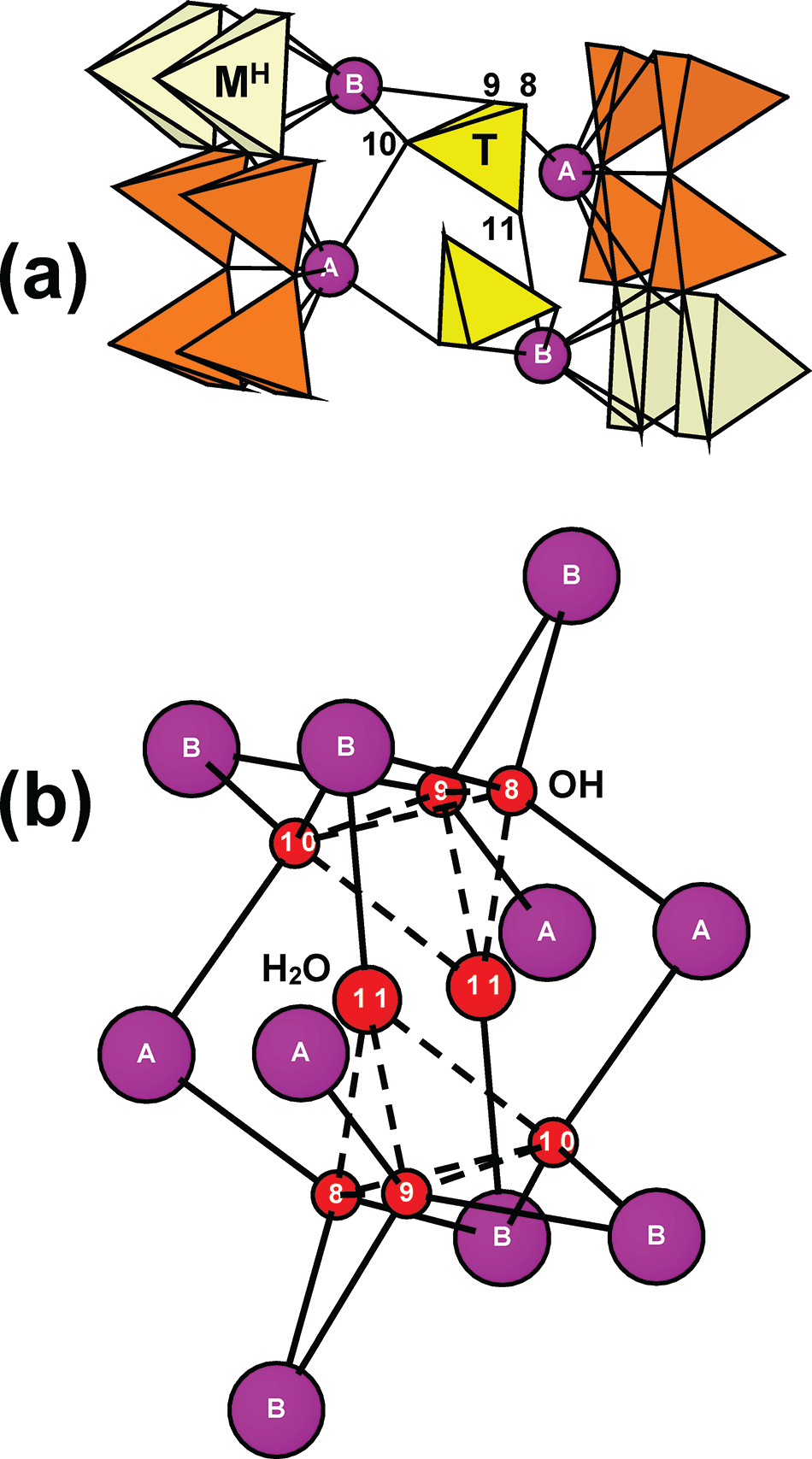
Figure 5. Details of short-range order of anions in the I block for ferroinnelite: (a) linkage of Ba atoms (at the [9]AP and [11]BP sites) and TO4 tetrahedra where T tetrahedra are fully occupied by S and P; (b) linkage of Ba atoms at the AP and BP sites via OH [O(8,9,10)] and H2O groups [O11] where T sites are vacant. Legend as in Fig. 4; Ba atoms at the AP and BP sites are shown as raspberry-coloured spheres and labelled A and B, respectively. Anions in the I block are (a) not shown where they are O atoms which coordinate T sites occupied by S and P and (b) shown as small red OH and large red H2O spheres where T sites are vacant. Thin black lines in (a) and (b) show Ba–O bonds; dashed lines in (b) show possible hydrogen bonds.
We write the cation part of the ideal formula as the sum of the cations of the I block + O sheet + two H sheets: Ba4(SP) + Na(NaFe2+)Ti + Ti2Si4 = Ba4Na(NaFe2+)Ti3Si4(SP) with a total charge of 51+.
Anion considerations
There are 13 anion sites in the crystal structure of ferroinnelite. In ferroinnelite, each anion site gives two anions pfu. Bond-valence values for anions are listed in Table 7. Seven anion sites, O(1–7), are occupied by O atoms which form the tetrahedral coordination of the Si atoms (Tables 4, 5). The [4]XOM anion receives bond-valence contributions from four cations: MH(Ti), MO2 (Na) and two MO3 (Na0.5Fe2+0.5), summing to 2.03 vu (Table 7) and it is an O atom (Fig 3a, b). Hence O(1–7) + XOM anions sum to O16 apfu.
Short-range order at the XOA site
In ferroinnelite, the [3]XOA anion receives bond-valence contributions from three cations: MO1 (Ti) and two MO3 (Na0.5Fe2+0.5) (Fig. 3a); note that the fourth cation, AP, occurs at a distance of 3.53 Å and hence does not contribute. The XOA anion receives bond valence of 1.20 vu and, from a long-range perspective, would be considered a monovalent anion. However, let us take into consideration the short-range order (SRO) of cations at the adjacent M O3 site, which is occupied by Na0.475M2+0.525 [= Na0.95(Fe2+0.64Mg0.21Mn2+0.19Ca0.01)Σ1.05 apfu]. Where the M O3 site is occupied by M2+, the adjacent XOA anion receives bond-valence from Ti at the M O1 site and two M2+ at the M O3 site (Fig. 3a), and the X OA site is locally occupied by O2–. Where the M O3 site is occupied by Na, the XOA anion receives bond valence from Ti at the M O1 site and two Na at the M O3 site (Fig. 3a), and the X OA site is occupied by the monovalent anions, (OH)– and F–. The M O3 site composition is Na0.475M2+0.525 [= Na0.95(Fe2+0.64Mg0.21Mn2+0.19Ca0.01)Σ1.05 apfu], and therefore the composition of the X OA site is O0.52(OH+F)0.48 [= O1.04(OH+F)0.96 pfu]. Chemical analysis gives F0.11 pfu (Table 1), and we write composition of the X OA site as O1.04(OH)0.85F0.11 pfu, ideally [O(OH)] pfu. The corresponding bond valence incident at the XOA anion should be ∼1.5 vu, and the lower value of 1.2 vu (Table 7) is probably due to the fact that dominance of Na at the M O3 site is responsible for longer distances.
Short-range order of anions in the  ${\textbf{\textit{I}}}$ block
${\textbf{\textit{I}}}$ block
In ferroinnelite, there are four anions, O(8–11), that coordinate the T site which is occupied by S0.94P0.89□0.17 (Table 6). These anions receive bond valences of 1.64–2.10 vu (Table 7), and hence are O atoms (Table 4). Barium atoms at the AP and BP sites and TO4 tetrahedra link via O(8–11). Where the T site is 91.5% occupied by S and P [(S,P)1.83□0.17], three anions are bonded to the T atom and three Ba atoms [O(8–10): AP and 2BP] and one anion to a Ba atom [O11: BP] (Table 5). The O(8–11) atoms give 0.915 × 4 = 3.66 O per TO4 group or 1.83 × 4 O = 7.32 O per S0.94P0.89 pfu. Where the T site is 8.5% vacant, the anions at the O(8–11) sites receive bond-valence solely from Ba atoms, 0.84, 0.83, 0.62 and 0.33 vu, respectively (Table 7) compatible with OH groups at the O(8–10) sites and an H2O group at the O11 site (Fig. 5b). Atom O11 has ADP max/min ratio of 17.4 prolate due to the occupancy of the O11 site by a [2]-coordinated O atom at 91.5% and a [1]-coordinated H2O group at 8.5%; hence the O11 atom is extremely positionally disordered.
The total content of OH and H2O groups is (OH)0.51(H2O)0.17 pfu. Hence the anion content of the O(8–11) sites is O7.32 (T site occupied) + (OH)0.51(H2O)0.17 (T site vacant) = O7.32(OH)0.51(H2O)0.17 pfu.
We write the ideal anion part of the ferroinnelite structure as the sum of the anion sites: O16 (14 O atoms of Si4 tetrahedra and 2 O atoms at the X OM site) + [O(OH)] (at the X OA site) + O8 (I block) = O25(OH) pfu, with a total charge of 51–. This is in accord with the ideal cation part of the structure, Ba4Na(NaFe2+)Ti3Si4(SP), with a total charge of 51+.
Structure topology
The main features of the structure topology of the ferroinnelite are in accord with the crystal structure of innelite reported by Chernov et al. (Reference Chernov, Ilyukhin, Maksimov and Belov1971) and refined by Sokolova et al. (Reference Sokolova, Cámara and Hawthorne2011). The structure is a combination of a TS block and an I block. The TS block consists of HOH sheets, and the O sheet is an octahedral close-packed sheet (Fig. 3a). In the H sheet, two Si tetrahedra link to form an Si2O7 group, and Si2O7 groups share vertices with the [5]-coordinated MH polyhedra (Fig. 3b). In ferroinnelite, the TS block exhibits linkage 1 and stereochemistry typical for the lamprophyllite group: two H sheets connect to the O sheet such that two Si2O7 groups link to trans edges of the Ti octahedron of the O sheet (Figs 3b, 4). The ideal composition of the TS block of the form MH2MO4(Si2O7)2(XOM)2(XOA)2 is {Ti2Na(NaFe2+)Ti(Si2O7)2O2[O(OH)]}3–. In accord with Sokolova (Reference Sokolova2006), MH2MO4(Si2O7)2(XOM)2(XOA)2 is the invariant core of the TS block in all TS-block structures. In ferroinnelite, the TS blocks alternate with intermediate I blocks. An I block is always intercalated between two TS blocks and cations of the I block form close-packed layers parallel to the TS block, where m denotes the number of those layers (Sokolova, Reference Sokolova2006). In innelite, there is one type of I block where m = 3. In two m layers, Ba atoms at the AP and BP sites are arranged in a close-packed fashion where each atom is surrounded by six others at approximately equal distances of 5 Å. The third, central, layer is composed of T tetrahedra of ideal composition [(SO4)(PO4)], where S:P = 1:1. In the I block of the ferroinnelite structure, Ba atoms connect via TO4 tetrahedra where the T site is occupied by S and P or via OH and H2O groups where the T site is vacant (Fig. 5). The ideal composition of the I block of the form AP 2BP 2(TO4)2 is {Ba4[(SO4)(PO4)]}3+.
Chemical formula
For ferroinnelite, we write the ideal structural formula of the form AP 2BP 2MH2MO4(Si2O7)2(TO4)2(XOM)2(XOA)2 as the sum of the ideal compositions of the TS block and I blocks: {Ti2Na(NaFe2+)Ti(Si2O7)2O2[O(OH)]}3– + {Ba4[(SO4)(PO4)]}3+ = Ba4Ti2Na(NaFe2+)Ti(Si2O7)2[(SO4)(PO4)]O2[O(OH)], where MH2 = cations of the H sheet = Ti2; MO4 = cations of the O sheet = Na(NaFe2+)Ti; XO4 = anions in the O sheet = O2[O(OH)]; AP 2BP 2 = cations at the P (peripheral sites) which belong to the I block = Ba4; central part of the I block = (TO4)2 = [(SO4)(PO4)].
Above, we reported the empirical formula for ferroinnelite (Table 1) calculated on the basis of 26 (O + F) anions: (Na1.95Fe2+0.64Mg0.21Mn2+0.19Ca0.02)Σ3.01(Ba3.84Sr0.13Na0.03)Σ4.00(Ti2.91Nb0.05Al0.02Zr0.01Mg0.01)Σ3.00Si4.02S0.94P0.89H1.70O25.89F0.11, Z = 1 and the structural formula based on assigned site-populations (Ba3.84Sr0.13Na0.03)Σ4(Ti1.98Al0.02)Σ2Na(Na0.95Fe2+0.64Mg0.21Mn2+0.19Ca0.01)Σ2(Ti0.93Nb0.05Zr0.01Mg0.01)Σ1(Si2O7)2[(SO4)0.94(PO4)0.89(OH)0.51(H2O)0.17]O2[O1.04(OH0.85F0.11)Σ0.96]Σ2. The validity of the ideal formula is supported by the close agreement between the charges for specific groups of cations in the ideal and structural formulae: 8+ for Ba4 versus 7.97+ for (Ba3.84Sr0.13Na0.03)Σ4; 8+ for Ti2 versus 7.98+ for (Ti1.98Al0.02); 4+ for Na(NaFe2+) versus 4.05+ for Na(Na0.95Fe2+0.64Mg0.21Mn2+0.1919Ca0.01); 5– for [(SO4)(PO4)] versus 5.06– for [(SO4)0.94(PO4)0.89(OH)0.51H2O0.17].
Summary
(1) The chemical composition of ferroinnelite has been determined. The ideal structural formula of ferroinnelite of the form AP 2BP 2MH2MO4(Si2O7)2(TO4)2(XOM)2(XOA)2 is Ba4Ti2Na(NaFe2+)Ti(Si2O7)2[(SO4)(PO4)]O2[O(OH)], where S:P = 1:1.
(2) Ferroinnelite, ideally Ba4Ti2Na(NaFe2+)Ti(Si2O7)2[(SO4)(PO4)]O2[O(OH)], is a new representative of titanium disilicate minerals with the TS block and a new member of the lamprophyllite group (Ti + Nb + Fe3+ + Mg = 3 apfu) of the seidozerite supergroup. Ferroinnelite belongs to the structure type B2(LG): B = basic, LG = lamprophyllite group.
(3) There are two substitutions in the O sheet of the TS block: Na+ ↔ Fe2+ at the M O3 site adjacent to the X OA site and OH– ↔ O2– at the X OA site, and these couple as follows: Na+ + OH– ↔ Fe2+ + O2–.
(4) There are two substitutions in the I block: T(S,P) ↔ T□ at the T site and O2– ↔ OH– + minor H2O at the anion sites which coordinate the T sites; they couple as follows: T(S,P) + O2– ↔ T□ + OH– + minor H2O.
(5) Ferroinnelite is isostructural with innelite-1A, ideally Ba4Ti2Na(NaMn2+)Ti(Si2O7)2[(SO4)(PO4)]O2[O(OH)] (Sokolova et al., Reference Sokolova, Cámara and Hawthorne2011; Sokolova and Cámara, Reference Sokolova and Cámara2017) (Table 8). Ferroinnelite and innelite are related by the following cation substitution at the M O3 site in the O sheet in the TS block: Fe2+fer ↔ Mn2+inn.
Table 8. Comparison of ferroinnelite and innelite-1A
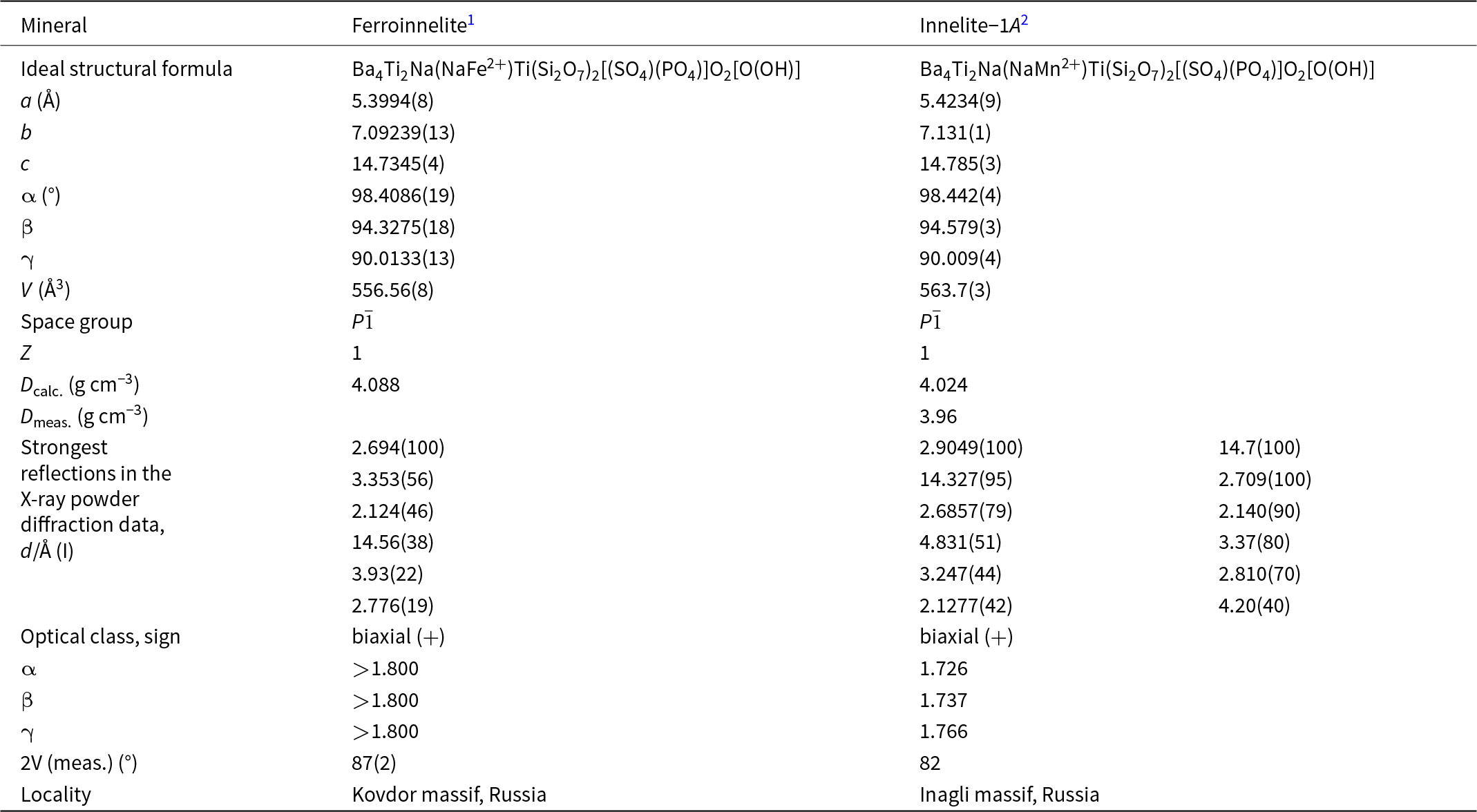
1 this work;
2 ideal structural formula, D calc., unit-cell parameters and space group are from Sokolova et al. (Reference Sokolova, Cámara and Hawthorne2011); D meas. and optical data are from Kravchenko et al. (Reference Kravchenko, Vlasova, Kazakova, Ilyukhin and Abrashev1961), power-diffraction data are from Raade and Berg (Reference Raade and Berg2000) (powder diffractometer Siemens D5005, left) and Pekov et al. (Reference Pekov, Chukanov, Kulikova and Belakovsky2006) (RKU-86 mm camera, right).
(6) IR and Raman spectroscopies confirmed the presence of OH and H2O groups in ferroinnelite and the holotype sample of innelite (sample 81801, Fersman Mineralogical Museum, Moscow, Russia).
Supplementary material
The supplementary material for this article can be found at https://doi.org/10.1180/mgm.2024.96.
Acknowledgements
We thank two anonymous reviewers and the Principal Editor Stuart Mills for the comments that helped to improve the manuscript. We are grateful to Dmitrii Belakovsky of the Fersman Mineralogical Museum, Moscow, Russia, for loan of the sample #81801 of innelite originally given to the Museum by S.M. Kravchenko and A.E. Efimov and used by Chernov et al. (Reference Chernov, Ilyukhin, Maksimov and Belov1971) to solve the crystal structure of innelite. F.C. Hawthorne was supported by a Discovery grant from the Natural Sciences and Engineering Research Council of Canada. F.C. Cámara was supported by the Italian Ministry of University (MIUR) through the project “Dipartimenti di Eccellenza 2023–2027”.
Competing interests
The authors declare none.
















